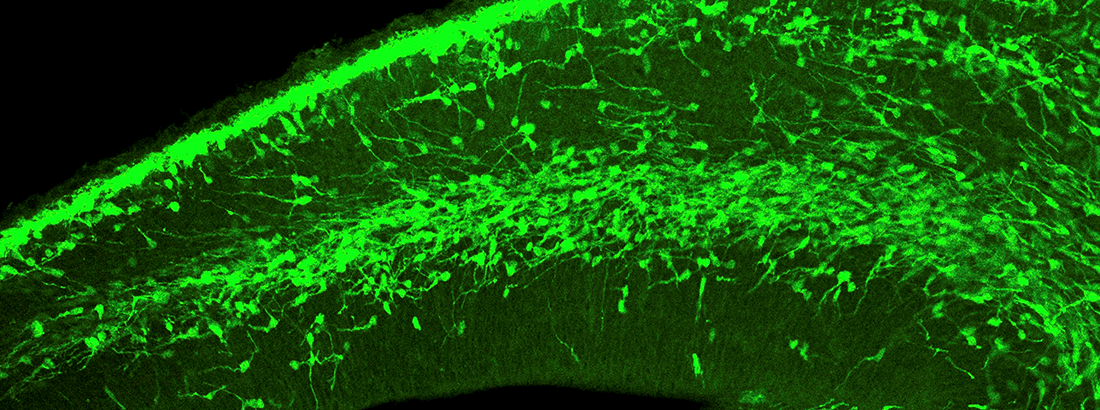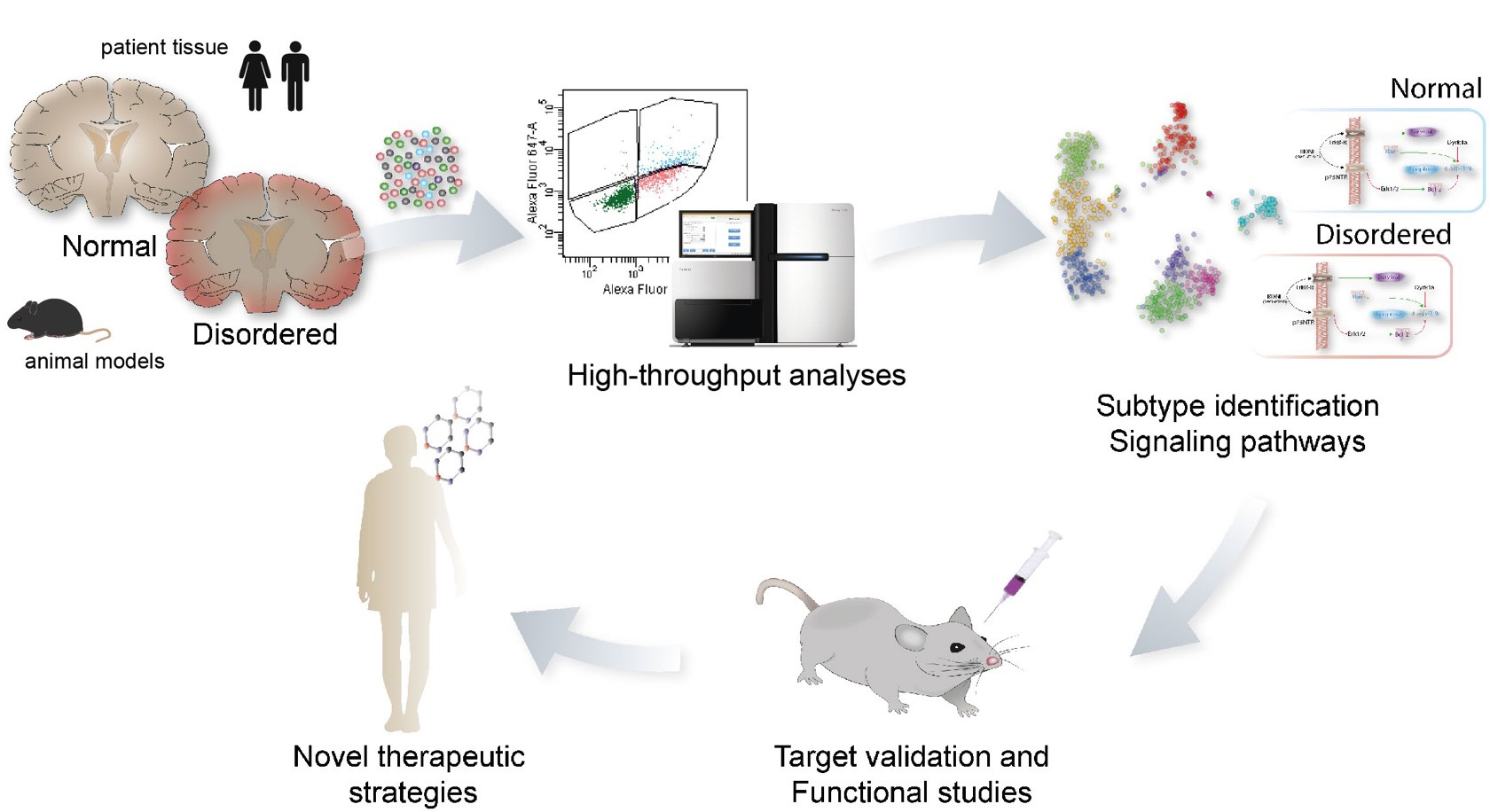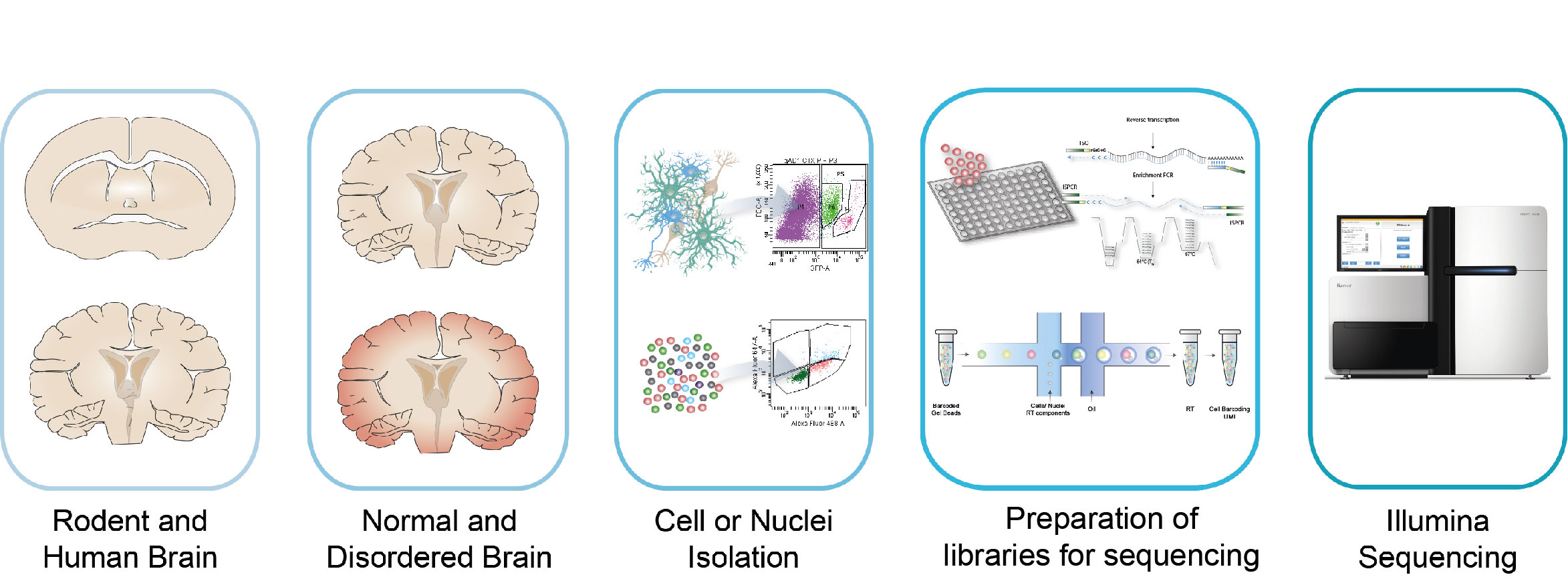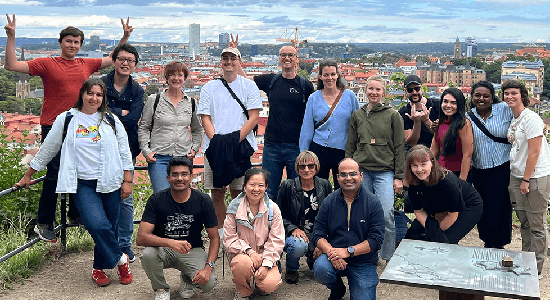Khodosevich Group

We aim to address the key questions for our understanding of brain function
- how such complex organ as the brain is build up during development?
- what goes wrong in neurodevelopmental disorders?
We study mechanisms that are responsible for neuronal specification, positioning and circuit formation during brain development, and how these mechanisms are impaired in neurodevelopmental disorders, such as schizophrenia, epilepsy, autism and others. In particular, we investigate how genetics and environment shape brain development and determine the vulnerability of neurons to developmental disorders.

Psychiatric/neurodevelopmental risk factors
- Response to genetic and environmental risk factors determines the vulnerability of neurons to psychiatric/neurodevelopmental disorders.
Read: Mol Psychiatry, Biol Psychiatry, Mol Psychiatry, Prog Neurobiol, EMBO J - The vulnerability of neurons strongly depends on the developmental period; thus, there are critical windows during which different types of neurons are particularly vulnerable or, conversely, resilient, and these periods vary across neuronal types.
Read: Mol Psychiatry, Biol Psychiatry, Mol Psychiatry - Our studies of specific risk factors:
- Maternal inflammation.
Read: Mol Psychiatry - Preterm birth.
Read: Science Advances, Cell Reports - 15q13.3 microdeletion.
Read: Neuron, Biol Psychiatry - Copy number variants (CNVs) in general.
Read: Biol Psychiatry, Biol Psychiatry
- Maternal inflammation.
Schizophrenia – neurodevelopmental etiology
- Although the phenotypic manifestations of schizophrenia emerge only during adolescence or early adulthood, the initial mechanisms that may trigger schizophrenia-associated brain dysfunction are already detectable during embryonic development.
Read: Neuron, Biol Psychiatry, Biol Psychiatry - The upper layers of the prefrontal cortex are most affected in schizophrenia and may represent a core substrate underlying the disorder’s symptomatology
Read: Science Advances - Long-range Somatostatin neurons as potential pacemakers of schizophrenia-related brain dysfunction.
Read: Neuron - Novel framework to idenfity disease mechanisms and drug targets in schizophrenia and psychiatric disorders in general.
Read: Nat Rev Drug Discov, Mol Psychiatry
Psychiatric and neurological brain disorders at single-cell resolution
- Schizophrenia: Upper cortical layer–driven network impairment in schizophrenia.
Read: Science Advances - Developmental epilepsy - Temporal lobe epilepsy: Epilepsy-associated neuronal subtypes and gene expression underlying epileptogenesis.
Read: Nat Commun - Developmental epilepsy – Tuberous sclerosis complex: Molecular structure preservation and massive reorganization of metabolism.
Read: bioRxiv
Normal brain development
- Neuronal specification in normal brain.
- Maturation of cortical GABAergic neurons.
Neurodevelopmental disorders
- Epilepsy:
- Mechanisms of epileptogenesis in human tissue and animal models.
- Functional characterization of human neurons in epileptic tissue
- Schizophrenia:
- Effects of environmental factors, such as maternal viral infections, inflammation, and pre-term birth on fetal brain development and postnatal brain maturation.
- Effects of schizophrenia-associated genetic mutations on fetal brain development and postnatal brain maturation.
- Formation of neuronal circuits underlying schizophrenia.
- Metabolic impairment in schizophrenia.
Single Cell Omics and Spatial Analysis
We are working to understand brain development and neurodevelopmental disorders at a molecular scale, and how various molecular perturbations alter the brain function. Our research extends from studying disease model rodent brains to human patient brain tissues. We apply single-cell and single-nucleus omics as well as spatial omics methods to profile molecular and spatial alterations in the tissue. Our approach provides a comprehensive insight into the alterations underlying impaired brain function in neurodevelopmental disorders.
Lab
- High-throughput profiling: We use the 10X Genomics Chromium platform. This droplet-based method enables profiling of several thousand of cells or nuclei in a parallel manner and thus permits the exploration of the cellular composition of a given tissue.
- High-resolution profiling: We use Smart-seq2 for high-resolution profiling of single-cells or nuclei. This method provides greater sequencing depth and thus potentially allows detecting subtle molecular alterations in the normal and disordered brain.
- Spatial profiling: We implement spatial analysis based on 10X Genomics Chromium platform allowing us to identify changes in cell composition and spatial location of molecular changes in disordered brains.

Bioinformatics
Following single-cell RNA sequencing, downstream analysis involves
Identification of differentially expressed genes and pathways
Clustering of the cells according to their gene expression
Visualisation and interactive exploration of the data
Characterisation of the disease-related changes
Integration of several modalities of single cell data (e.g. transcriptome and epigenome), integration with genetics, with spatial data etc.

Tools we commonly use for these tasks include the packages Cacoa, Conos, Pagoda 2, velocyto, scanpy and paga, as well as pipelines as dropest, CellRanger, stereoscope and CellPhoneDB.
Selected publications
Major Experimental papers
Asenjo-Martinez A#, Dragicevic K#, Hou WH#, Ozsvar A, Hansen N, Pfisterer U, Rydbirk R, Demharter S, Møller B, Gasthaus J, Korshunova I, Perrier JF, Capogna M, Vasistha NA#, Khodosevich K# (2025) Dysfunction of cortical GABAergic projection neurons as a major hallmark in a model of neuropsychiatric syndrome. Neuron, 113(19):3204-3223.e11
Batiuk M#, Tyler T#, Dragicevic K, Mei S, Rydbirk R, Petukhov V, Deviatiiarov R, Sedmak D, Frank E, Feher V, Habek N, Hu Q, Igolkina A, Roszik L, Pfisterer U, Garcia-Gonzalez D, Petanjek Z, Adorjan I, Kharchenko P, Khodosevich K (2022) Upper cortical layer–driven network impairment in schizophrenia. Sci Adv 8, eabn8367
Malwade S, Gasthaus J, Bellardita C, Andelic M, Moric B, Korshunova I, Kiehn O, Vasistha NA, Khodosevich K. (2022) Identification of vulnerable interneuron subtypes in 15q13.3 microdeletion syndrome using single-cell transcriptomics. Biol Psychiatry, 91(8): 727-739
Pfisterer #, Demharter S.#, Petukhov V.#, Meichsner J.#, Thompson J., Batiuk M., Asenjo Martinez A., Vasistha N., Thakur A., Mikkelsen J., Adorjan I., Pinborg L., Pers T., von Engelhardt J., Kharchenko P., Khodosevich K. (2020) Identification of epilepsy-associated neuronal subtypes and gene expression underlying epileptogenesis. Nat Commun, 11(1):1-19
Vasistha N.#, Pardo-Navarro M.#, Gasthaus J., Weijers D., Müller M., García-González D., Malwade S., Korshunova I., Pfisterer U., von Engelhardt J., Hougaard K., Khodosevich K. (2019) Maternal inflammation has a profound effect on cortical interneuron development in a stage and subtype-specific manner. Mol Psychiatry, 25: 2313–2329
Sanz Morello B., Pfisterer U., Hansen N., Demharter S., Thakur A., Fujii K., Levitskiy S., Montalant A., Korshunova I., Mammen P., Kamenski P., Noguchi S., Aldana Garcia B., Hougaard K., Perrier J., Khodosevich K. (2020) Unique isoform in oxidative phosphorylation machinery supports the function of fast-spiking neurons. EMBO J, 39(18):e105759
Major Computational papers
Malwade S, Sellgren C, Vasistha NA#, Khodosevich K# (2025) Rare copy number variants reveal critical cell types and periods of brain development in neurodevelopmental disorders. Biol Psychiatry: GOS, 5(4):100495
Petukhov V#, Igolkina A#, Rydbirk R, Mei S, Christoffersen L, Khodosevich K#, Kharchenko P# (2022). Case-control analysis of single-cell RNA-seq studies. bioRxiv 2022.03.15.484475.
Petukhov V, Xu R, Soldatov RA, Cadinu P, Khodosevich K, Moffitt J, Kharchenko P. (2021) Cell segmentation in imaging-based spatial transcriptomics. Nat Biotech, 40(3): 345-354
Barkas N.#, Petukhov V.#, Nikolaeva D., Lozinsky Y., Demharter S., Khodosevich K., Kharchenko PV. (2019). Joint analysis of heterogeneous single-cell RNA-seq dataset collections. Nat Methods, 16: 695–698
Major Reviews & Perspectives
Malwade S, Ingason A, Khodosevich K. (2025) The Use of Single-Cell and Spatial Omics to Study Copy Number Variants. Biol Psychiatry. Jun 20:S0006-3223(25)01269-7.
Khodosevich K, Dragicevic K, Howes O. (2024) Drug targeting in psychiatric disorders – how to overcome the loss in translation? Nat Rev Drug Discovery, 23: 218–231
Khodosevich K, Sellgren CM. (2023) Neurodevelopmental disorders—high-resolution rethinking of disease modeling. Mol Psychiatry 28(1):34-43
Press releases
Researchers aim to reveal mechanisms leading to schizophrenia.
Huge unveiling of schizophrenia brain cells show new treatment targets.
Researchers identify gene heavily linked to psychiatric disease.
Study identifies brain cells most affected by epilepsy and new targets for their treatment.
BRIC researchers discover role of metabolism gene in brain dysfunction.
How are psychiatric disorders linked to infections during pregnancy?
Surprising Research Result: All Immature Cells Can Develop into Stem Cells.
Media coverage
Mental disorders often trace back to fetal development
One congenital gene insult is probably the basis for neurodevelopmental disorders
Forskere fra KU åbner op for nye måder at behandle skizofreni
Forskere på KU afslører de specifikke neuron-fejl bag skizofreni
A specific gene is linked to autism, ADHD, schizophrenia, and other diagnoses
Defekt gen er kimen til udvikling af mange psykiatriske sygdomme
Et bestemt gen kobles til bla ADHD
Public talks
2023: Bien Contemporary Art Gallery, FRIENDLY MONSTERS Gallery Talk: Understanding Schizophrenia
Main collaborators
Atsushi Takata, CBS RIKEN, Japan
Benedicto Crespo-Facorro, Sevilla University, Spain
Carl Sellgren, Karolinska Institutet, Stockholm
Dirk Isbrandt, DZNE Bonn, Germany
Jean-Francois Perrier, University of Copenhagen, Denmark
Jeffrey Moffit, Harvard Medical School, USA
Kazunobu Sawamoto, Nagoya City University, Japan
Lars Pinborg, Rigshospitalet, Denmark
Peter Kharchenko, Harvard Medical School, USA
Susana Aznar, Bispebjerg Hospital, Denmark
Tune Pers, University of Copenhagen, Denmark







